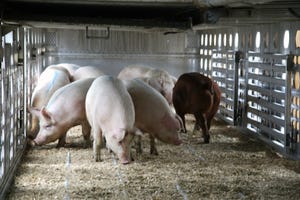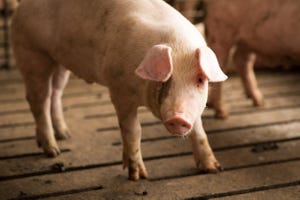From whiteboards to dashboards: How to transition your sow farm to digital data
Data capture increases accessibility to both in-farm and outside-farm consultants, and provides immediate tracking of production targets from sow events recorded that same day.
September 6, 2023
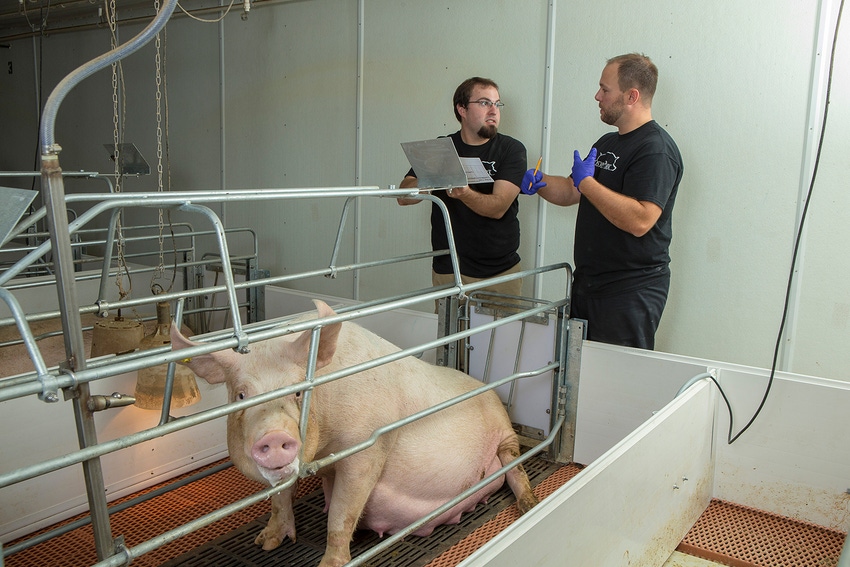
By Kim Flannery, MetaFarms
With the progress towards providing internet access in rural locations, sow farms now have a new generation of digital tools to manage their farm operations. But walk into any sow farm office, and the first thing you are likely to notice is a wall covered with at least one, if not several, whiteboards.
Sow farms have used whiteboards for decades as a visual tool for organizing important information needed to ensure efficient management of the health and productivity of the animals in their care. They provide a centralized location to track tasks for daily management, such as feeding schedules, medication protocols and health checks. They allow farms to monitor various parameters related to the sows’ reproductive performance, such as breed groups, farrowing rates and wean information.
Below are some examples of how one farm uses its whiteboards to represent its weekly production data visually.
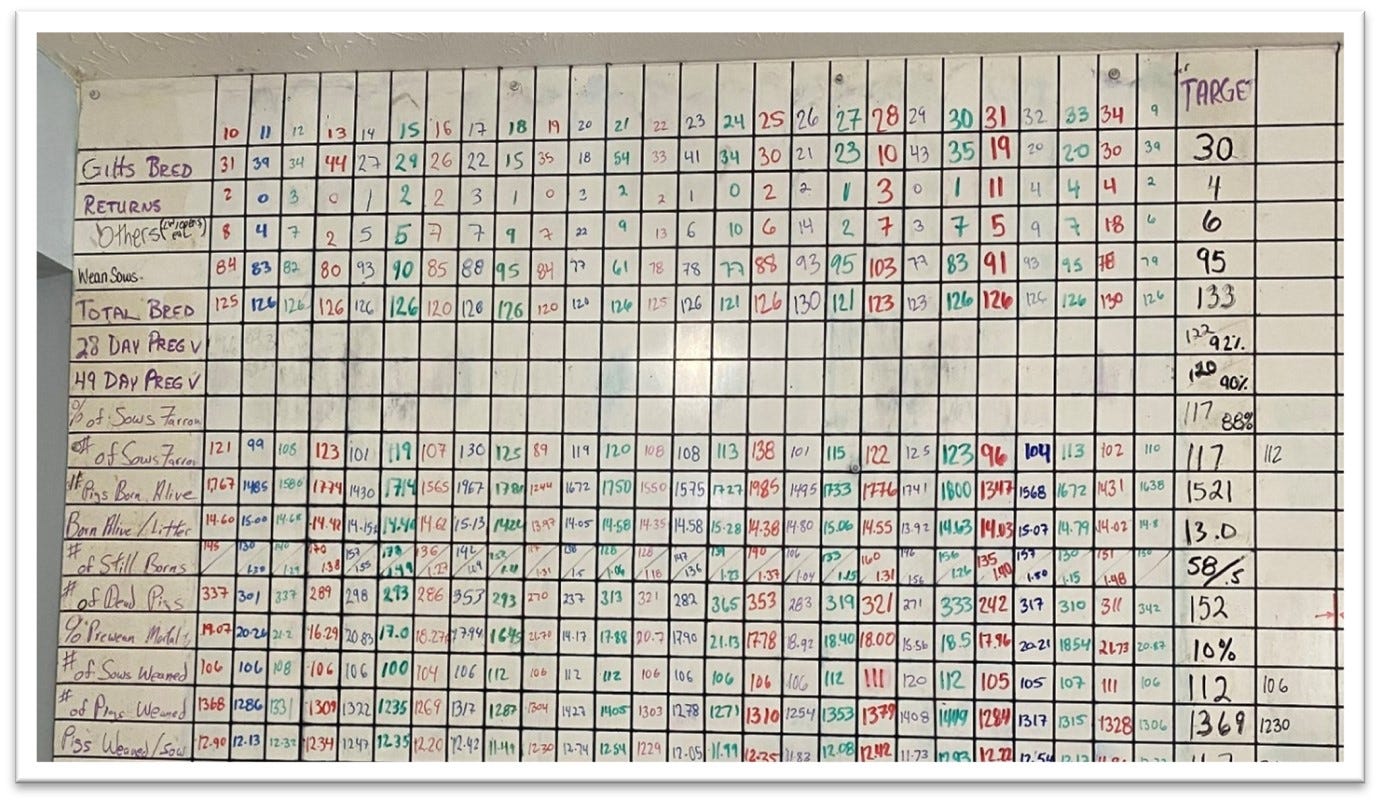
MetaFarms
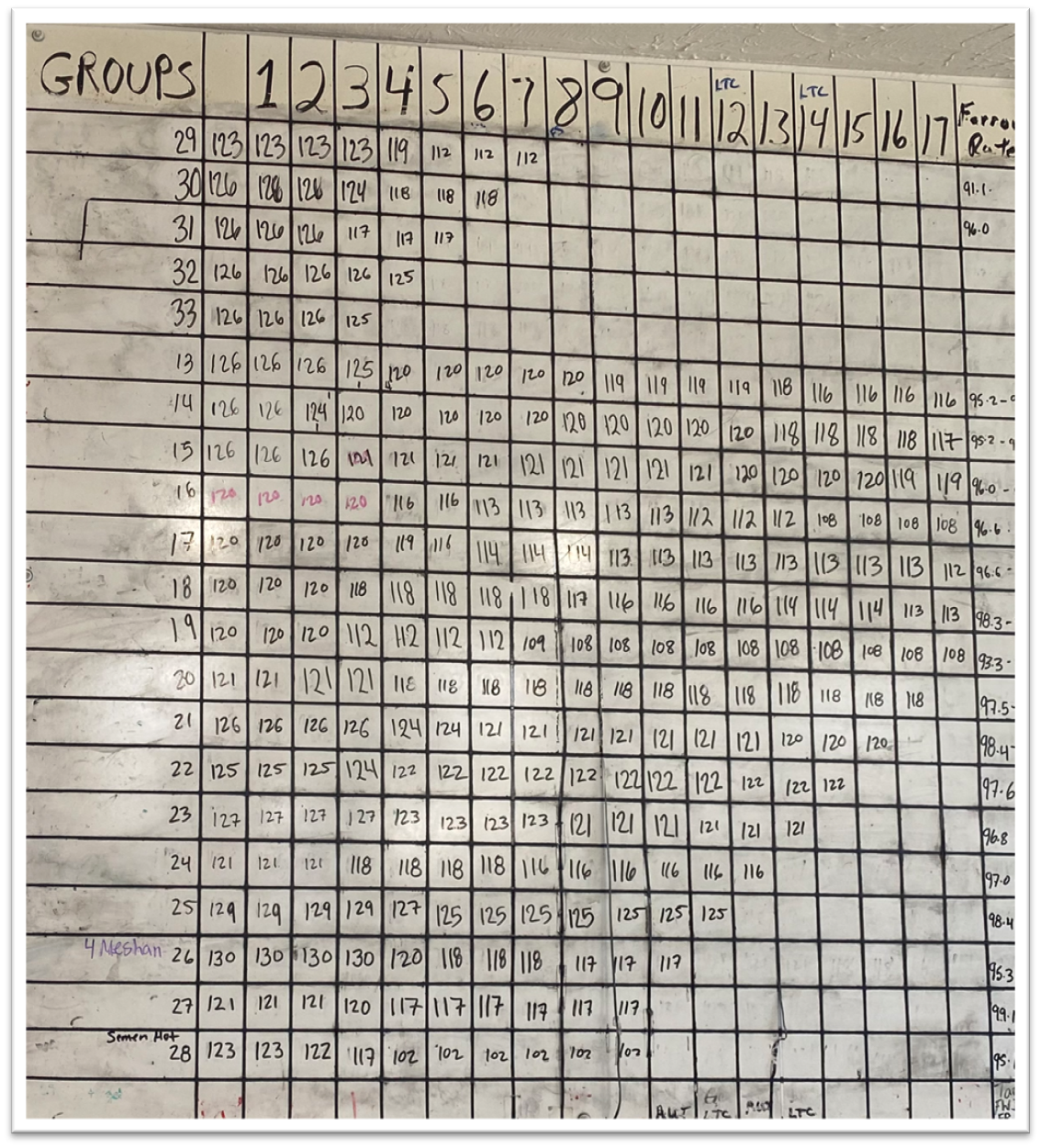
MetaFarms
While whiteboards offer several benefits, there are also some potential disadvantages and limitations to consider when using them. Whiteboards can only contain a limited amount of information based on the surface area of the board, which can lead to insufficient data being represented or trying to squeeze too much information into a small space, which can be hard to read.
Because whiteboards are fixed in a specific location, they may not be easily accessible to remote or off-site staff members like supervisors, management or veterinarians who need access to the data. Because the data and information on the whiteboards is updated by hand, there is a concern for errors or simply the question of "are these the latest numbers, or does this whiteboard need to be updated?"
However, thanks to the increasing accessibility of internet access in rural farm locations, sow farms are beginning to address these limitations with digital solutions. As shown in the pictures below, by recording all sow farm production data in real-time on a tablet or phone app, and incorporating large monitors to display digital dashboards, many sow farms have reduced or eliminated their dependence on the whiteboard for daily and weekly production information.
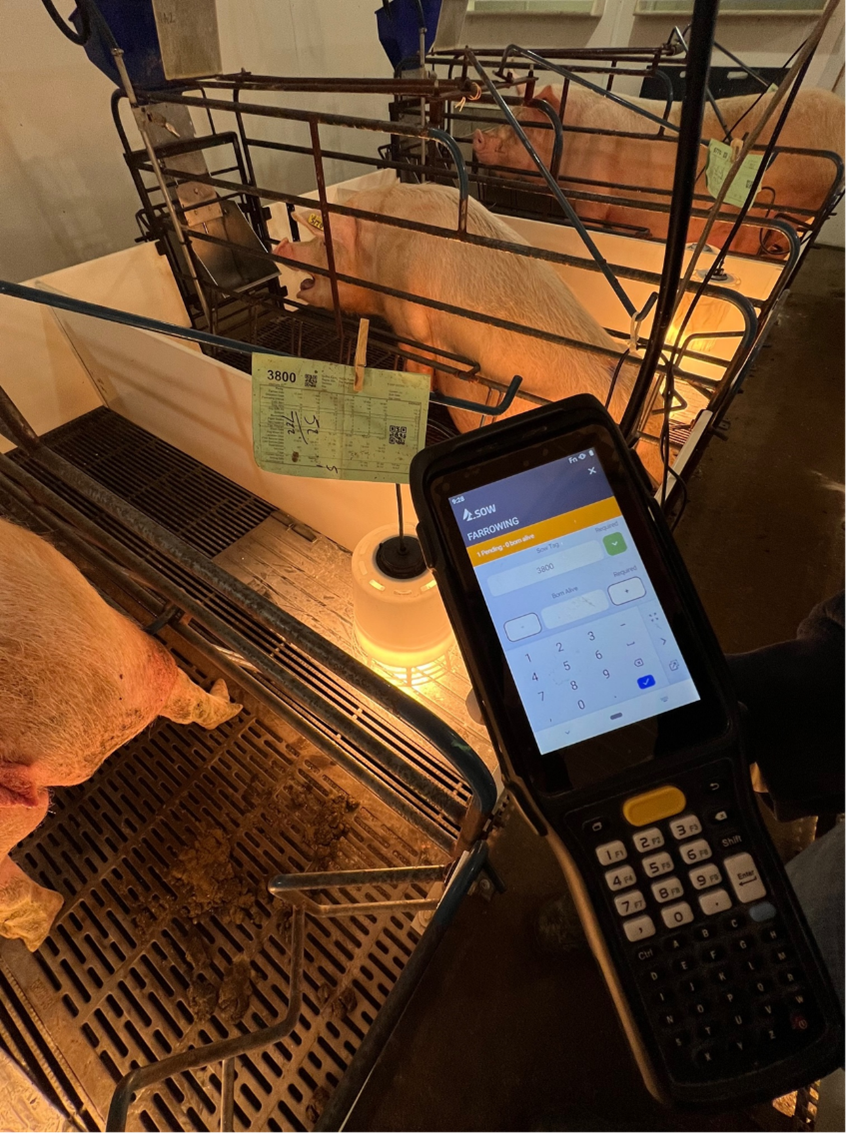
MetaFarms
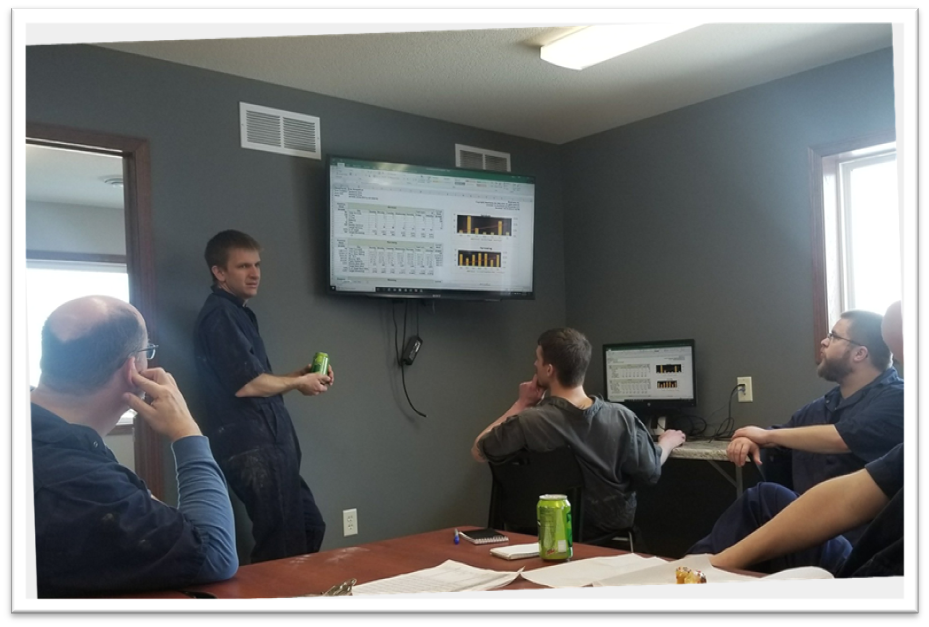
MetaFarms
Deploying this type of data capture and reporting system in your farm, will enhance your data management capabilities, increasing accessibility to both in-farm and outside-farm consultants, and providing immediate tracking of production targets from sow events recorded that same day. This system dramatically improves the data recording process while providing visual data organization benefits to the farm.
Farms have access to several data visualization tools available from MetaFarms. Our Analytical Insights dashboards are powered by Microsoft Power BI and provide interactive production dashboards displaying the sow farm’s key performance metrics and production data, as well as progress towards the farm’s targets. These tools allow for straightforward interpretation and analysis of complex data sets, enabling farm managers to identify trends, patterns and areas for improvement.

MetaFarms
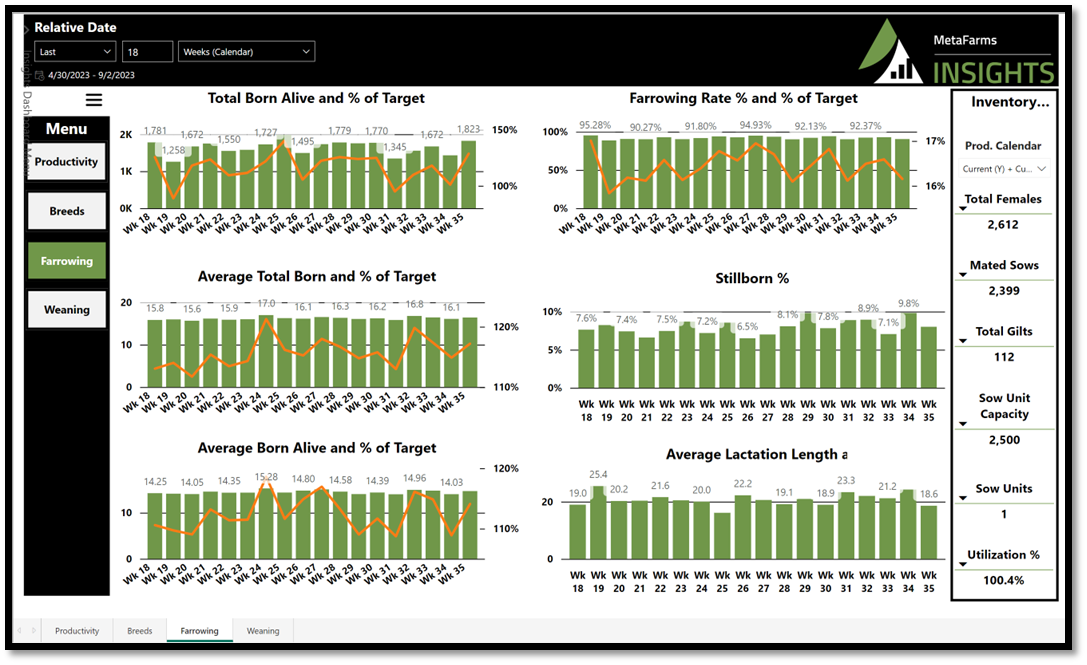
MetaFarms
Digital transformation
When you are ready to transition from manual whiteboards to digital visual data, it is important to create a plan with clearly defined goals to guide you in achieving a successful transition. Begin by looking at the information you currently track on your whiteboards, now is an excellent time to address any specific challenges or pain points in your current data-tracking processes.
Evaluate and determine the herd management software provider you would like to work with to make this transition. Thoroughly research software providers that offer solutions aligned with your requirements. Carefully evaluate their features, integrations, customer support and pricing. Request demos or trials to get firsthand experience with the software and assess its suitability for your sow farm.
Determine how to migrate the existing data from whiteboards to the digital system. The migration may involve inputting data manually, importing data from spreadsheets or other digital formats, or utilizing data conversion services provided by the software provider. Develop a comprehensive plan to smooth the transition and minimize data loss or errors.
Your herd management software provider will help you configure the digital system according to your sow farm's needs. They should provide you with mobile applications that allow you to capture your farm production data and provide you with ideas to display it visually in a clear and easily understandable way.
Smooth transition to digital
Transitioning to a new digital system in a sow farm can be a significant change. Still, there are several strategies you can employ to provide a smooth transition during the adoption process.
Develop a detailed plan for the transition process, including timelines, roles and responsibilities. Communicate the reasons for the change, its benefits and the expected timeline to all relevant stakeholders, including farm personnel, managers and other key individuals. Address any concerns or questions they may have and provide opportunities for open dialogue throughout the process.
Training is crucial to help your farm personnel understand the new system and feel confident using it. Provide extensive training sessions that cover the functionalities, workflows and features of the digital system. Offer firsthand practice opportunities, training materials and ongoing support channels, such as online tutorials or a dedicated support staff, to address any questions or difficulties.
Rather than abruptly discontinuing the use of whiteboards, consider a phased approach. Start by using both the whiteboards and the digital system simultaneously, gradually reducing reliance on the whiteboards over time. It allows for a smoother transition and reduces the risk of disruptions to farm operations.
Establish a support system to assist farm personnel during the transition. Include dedicated support staff available to answer questions, address concerns and provide guidance. Offer resources such as user manuals, FAQs and online tutorials to help employees navigate the new system effectively. Encourage an environment where individuals feel comfortable seeking assistance and sharing feedback.
Monitor the adoption process and identify any challenges or obstacles. Actively seek feedback from farm personnel to understand their experiences and address any issues promptly. Regularly communicate progress updates and address concerns transparently. Adjust training, workflows or system configurations to optimize the adoption process.
Recognize and celebrate milestones achieved during transition. Acknowledge and appreciate the efforts of farm personnel in adapting to the new system. Fostering a positive attitude towards change motivates individuals to continue embracing the new digital solution.
By following these steps, maintaining open communication lines, providing comprehensive training and support, and gradually implementing the new system, your sow farm can minimize disruptions and ensure a smoother transition to a digital solution.
Monitor the transition
To effectively monitor the adoption process and address challenges during the transition to a new digital system in a sow farm, there are a few strategies you can deploy.
Begin by establishing key metrics and goals that will help gauge the progress of the adoption process. These metrics can include factors such as the number of farm personnel trained, the percentage of data entered into the new system, or reduced reliance on whiteboards. By setting clear targets, you can track the adoption rate and identify any areas needing improvement.
Communicate often and gather feedback from farm personnel throughout the adoption process. Conduct regular check-ins or feedback sessions to gather insights on their experiences, challenges, and suggestions for improvement. Encourage honest and constructive feedback, and address concerns or questions promptly. This communication helps identify areas of improvement and allows you to address challenges proactively.
Utilize the software’s usage reports to help you monitor the usage of the new digital system to ensure that personnel are actively using it as intended. Track the frequency and consistency of data entry to ensure the system is integrated into daily operations. Additionally, monitor the quality of the data being entered to identify any issues or inconsistencies that may require further training or system adjustments.
Do not neglect to provide ongoing training and support. Any transition to a new workflow or process requires continuous training and support. Offer refresher training sessions, workshops, or online resources to reinforce the knowledge and skills required to use the new system effectively. Consider creating a reference tool of standard operating procedures for the new workflow, include a how-to for mobile data entry and the digital visual tools. Many farms have a dedicated help desk or support person in-house they can reach out to, to address any questions or challenges during the adoption process.
Anticipate resistance; it is quite common during farm workflow transitions. Identify individuals or teams that may be resistant and proactively address their concerns. Engage in open dialogue, provide additional training or support if needed, and emphasize the new system's benefits. Addressing resistance early on can help prevent it from becoming a significant obstacle to adoption.
Continuously evaluate the adoption process and adjust as needed. Analyze feedback, identify patterns or recurring challenges, and refine training materials or workflows accordingly. Be flexible and willing to adapt the implementation strategy based on what you learned during the transition process.
By implementing these strategies, you can closely monitor the adoption process, address challenges as they arise, and create a supportive environment that encourages the successful adoption of the new digital system in your sow farm.
If you would like to discuss how to complete a successful digital transformation on your farm, or if you have suggestions on production areas to be included in future articles, please e-mail, or call us. We enjoy being a part of the National Hog Farmer Weekly Preview team. Previous Production Preview columns can be found at National Hog Farmer.
If you have questions or comments about these columns, or if you have a specific topic that you would like us to write about, please contact: Flannery via email.
You May Also Like

